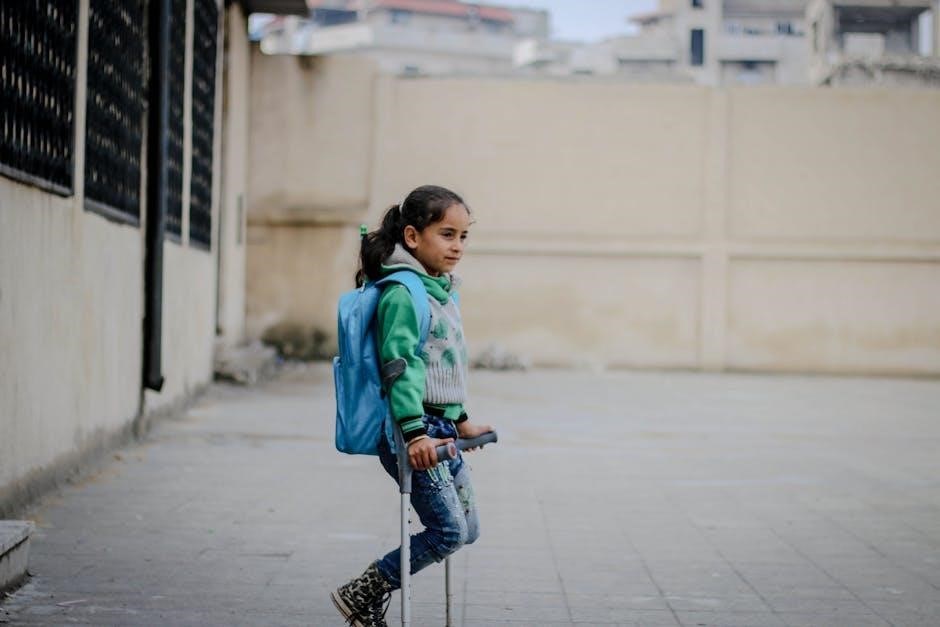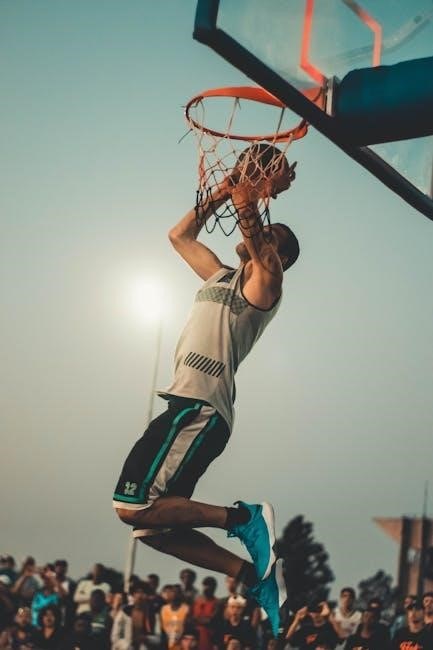Playgrounds, meant to foster fun and growth, can sometimes become sites of unfortunate injuries. This article explores the severity of such incidents, their causes, and preventive solutions.
1.1. Overview of the Topic
Gruesome playground injuries refer to severe incidents occurring in recreational areas, often resulting in significant harm. These injuries can involve physical trauma, long-term health issues, or even psychological distress. Common causes include falls, collisions, or equipment malfunctions. The emotional and psychological impact on children and families cannot be overlooked. Understanding these incidents is crucial for developing effective prevention strategies and promoting safer environments for children.
1.2. Importance of Addressing Playground Injuries
Addressing playground injuries is crucial to prevent long-term physical and emotional trauma. Severe injuries can lead to pain, disability, and psychological distress, affecting a child’s development. Prompt action ensures safety, reduces medical costs, and fosters a culture of prevention. By prioritizing safety, we create environments where children can thrive without fear, promoting their well-being and future success through proactive measures.
1.3. Purpose of the Article
This article aims to raise awareness about the severity and frequency of playground injuries. It provides insights into their causes, consequences, and prevention strategies. By exploring real-life cases and expert recommendations, the article seeks to equip parents, educators, and policymakers with the knowledge needed to create safer playground environments, ensuring children can play safely and healthily.
Understanding Gruesome Playground Injuries
Gruesome playground injuries often involve severe physical harm, leaving lasting emotional and psychological effects on children. Understanding their nature is crucial for effective prevention and support.
2.1. Definition and Scope
Gruesome playground injuries involve severe harm, often requiring medical attention, and can include fractures, head trauma, or lacerations. These incidents occur during play, affecting children physically and emotionally, with long-term consequences. Understanding their scope helps identify risks and preventive measures, ensuring safer environments for children to thrive and learn through play.
2.2. Common Types of Playground Injuries
Common injuries include fractures, sprains, and head trauma from falls, collisions, or equipment impact. Cuts, bruises, and abrasions often result from sharp objects or rough surfaces. Strangulation can occur from ropes or chains, while entrapment injuries happen when body parts get stuck in equipment. Burns may occur from hot surfaces, and concussions are frequent in high-impact accidents, emphasizing the need for vigilance and safety measures.
2.3. The Emotional and Physical Toll
Playground injuries can leave children with lasting emotional scars, such as anxiety, fear, and a loss of confidence. Physical pain, limited mobility, and potential long-term disabilities add to the burden. The trauma may also lead to mental health challenges, impacting a child’s ability to engage in normal activities and interact socially, highlighting the need for compassionate care and support.
Causes of Gruesome Playground Injuries
Playground injuries often result from a combination of factors, including unsafe equipment, lack of supervision, and rough play among children, all of which significantly increase the risk of harm.
3.1. Poor Supervision
Poor supervision is a leading cause of playground injuries, as children often lack the judgment to assess risks. Without proper adult oversight, dangerous behaviors may go unchecked, leading to accidents. Supervisors may fail to intervene in risky play or not notice potential hazards, increasing the likelihood of severe injuries. This lack of monitoring can result in falls, collisions, and other preventable harm to children.
3.2. Inadequate Safety Measures
Inadequate safety measures significantly contribute to playground injuries. This includes outdated equipment, lack of soft landing surfaces, and insufficient padding. Without proper maintenance, equipment can become unsafe, leading to accidents. Additionally, failure to enforce safety guidelines, such as age restrictions on equipment, can result in injuries. These oversights highlight the importance of prioritizing safety protocols to protect children from preventable harm.
3.3. Faulty Playground Equipment
Faulty playground equipment is a primary cause of injuries. Broken swings, rusty hardware, and unstable structures can lead to severe accidents. Equipment defects often result from poor manufacturing or lack of maintenance. Sharp edges, protruding bolts, and worn-out surfaces further increase risks. Regular inspections and timely repairs are essential to ensure equipment safety and prevent devastating injuries that can have long-lasting consequences for children.
3.4. Rough Play and Bullying
Rough play and bullying on playgrounds often lead to injuries. Pushing, hitting, or intentional collisions can result in falls, fractures, or head injuries. These actions, fueled by aggression or intent to harm, create unsafe environments. Supervision and intervention by adults are crucial to prevent such incidents. Addressing underlying behaviors and promoting kindness can significantly reduce the risk of harm caused by rough play and bullying.

Preventing Playground Injuries
Preventing playground injuries requires a proactive approach, combining proper supervision, safe equipment, and educating children on responsible play. A culture of safety maximizes fun while minimizing risks.
4.1. Role of Adults and Caregivers
Adults and caregivers play a crucial role in preventing playground injuries by ensuring active supervision, enforcing safety rules, and promptly addressing hazards. They should educate children on proper equipment use, encourage respectful play, and maintain open communication to address concerns. Regular inspections of playground equipment and ensuring proper fall surfaces are also key responsibilities. Their vigilance helps create a safer environment for children to thrive.
4.2. Importance of Safety Guidelines
Safety guidelines are essential for minimizing playground risks. They establish standards for equipment installation, maintenance, and usage, ensuring compliance with safety protocols. Clear guidelines help prevent accidents by addressing potential hazards and promoting responsible behavior. By adhering to these rules, both children and supervisors can contribute to a safer environment, reducing the likelihood of injuries and fostering a culture of safety and awareness.
4.3. Regular Maintenance of Playground Equipment
Regular maintenance of playground equipment is crucial for preventing injuries. Consistent inspections and timely repairs can identify and address potential hazards before they escalate. Proper upkeep ensures equipment durability and safety, aligning with established safety standards. A well-maintained playground not only reduces the risk of accidents but also fosters a secure environment for children to play and grow, minimizing liability and promoting overall well-being.
The Role of Education in Injury Prevention
Education plays a pivotal role in reducing playground injuries by promoting awareness and responsible behavior among children, caregivers, and communities, fostering a culture of safety and vigilance.
5.1. Teaching Children About Safety
Teaching children about safety is crucial for preventing injuries. Age-appropriate guidelines, demonstrations, and discussions help kids understand risks and proper behaviors. Encouraging children to report hazards, follow rules, and stay within designated areas reduces accidents. Supervision and positive reinforcement further instill safe practices, fostering a culture of awareness and responsibility from a young age, ultimately protecting them from harm.
5.2. Training for Playground Monitors
Training playground monitors is essential to ensure a safe environment. Monitors should learn injury prevention techniques, conflict resolution, and emergency response. They must recognize hazards, enforce safety rules, and provide immediate first aid. Continuous education and updates on safety protocols empower monitors to effectively manage playground activities, reducing risks and fostering a culture of vigilance and care among children and staff alike.
5.3. Community Awareness Programs
Community awareness programs play a vital role in preventing playground injuries; These initiatives educate parents, children, and caregivers about safety practices, hazard identification, and proper supervision. Workshops, seminars, and campaigns encourage active participation, fostering a collective responsibility for safety. By raising awareness, communities can create safer environments, reducing the risk of accidents and promoting healthier play experiences for all children.

Legal Implications of Playground Injuries
Playground injuries often lead to legal consequences, including liability claims and negligence lawsuits. Understanding these implications is crucial for schools and recreational facilities to ensure safety and accountability;
6.1. Liability and Negligence
Liability and negligence are critical legal concepts in playground injury cases. Property owners, schools, or equipment manufacturers may be held responsible if injuries result from their failure to ensure safety. Negligence occurs when a duty of care is breached, leading to harm. Courts often assess whether reasonable precautions were taken to prevent accidents, making it essential for entities to maintain strict safety standards and supervision.
6.2. Lawsuits and Compensation
Lawsuits often arise when playground injuries result from negligence or faulty equipment. Plaintiffs may seek compensation for medical expenses, pain, and emotional distress. Courts assess damages based on severity and responsibility. Settlements or rulings can provide financial relief, but legal battles can be lengthy. Victims may also receive compensation through insurance claims or out-of-court agreements, ensuring some form of accountability and support for recovery.
6.3. The Need for Strict Safety Regulations
Strict safety regulations are essential to minimize playground injuries and ensure accountability. Clear guidelines for equipment, maintenance, and supervision help prevent accidents. Regulatory bodies must enforce these standards to protect children and reduce legal liabilities. Compliance with safety protocols fosters a safer environment, promoting fun and learning while safeguarding young lives from potential harm and long-term consequences.
The Psychological Impact of Injuries
Playground injuries can cause psychological trauma, anxiety, and fear in children. Emotional support and counseling are crucial for their mental recovery and well-being.
7.1. Trauma and Anxiety in Children
Gruesome playground injuries can leave children with emotional scars, including fear, anxiety, and post-traumatic stress. The trauma often stems from pain, loss of security, and fear of recurrence. This emotional distress can hinder social interactions and development, requiring specialized support to help them heal and regain confidence in their environment.
7.2. Long-Term Effects on Mental Health
Children who experience gruesome playground injuries may face lasting mental health challenges, including anxiety, depression, and social withdrawal. These injuries can create a deep-seated fear of physical activities and public spaces. Over time, unresolved trauma may impair emotional development and self-esteem, emphasizing the need for early intervention and psychological support to foster long-term recovery.
7.3. Coping Mechanisms for Recovery
Children often benefit from therapy, such as cognitive behavioral therapy, to address emotional scars. Support groups provide a space to share experiences and reduce isolation. Mindfulness and relaxation techniques can help manage anxiety. Creative outlets like art or music offer an expressive way to process trauma. Peer support and positive reinforcement from caregivers are also vital for fostering resilience and aiding recovery.

First Aid and Emergency Response
Effective first aid and emergency response are crucial in minimizing harm from playground injuries. Quick assessment, proper wound care, and knowing when to seek help is essential.
8.1. Immediate Actions After an Injury
Ensure the child’s safety first, then assess the injury. Check for breathing and consciousness, and avoid moving them if a neck or back injury is suspected. Control bleeding with direct pressure using a clean cloth, and avoid tourniquets unless necessary. Stay calm, reassure the child, and seek immediate professional help if the injury is severe or life-threatening.
8.2. When to Seek Professional Help
Seek immediate medical attention if the injury involves deep wounds, broken bones, head trauma, or loss of consciousness. Severe pain, difficulty breathing, or signs of shock also require urgent care. Even minor injuries should be evaluated if they don’t improve with basic first aid or if there’s a risk of infection or long-term damage.
8.3. The Role of First Aid Kits
A well-stocked first aid kit is essential for responding to playground injuries. It should include bandages, antiseptics, gloves, and tools to stop bleeding or immobilize injuries. Regularly checking and restocking the kit ensures readiness for emergencies, helping to prevent minor injuries from escalating and providing critical care until professional help arrives.

Real-Life Cases of Gruesome Playground Injuries
This section examines real-life incidents of severe playground injuries, illustrating common hazards and emphasizing the necessity of enhanced safety measures to protect children.
9.1. Case Study 1: Falls from Equipment
A 7-year-old boy fell from the top of a monkey bar setup, landing on his head. The impact caused a severe concussion and fractured wrist. The lack of proper cushioning beneath the equipment exacerbated the injuries. The incident led to a prolonged recovery, highlighting the dangers of inadequate safety measures and the importance of proper supervision. The case underscores preventive strategies to minimize such risks.
9.2. Case Study 2: Injuries from Sharp Objects
A 9-year-old girl suffered a deep laceration when she stepped on a shattered bottle hidden in the sand. The injury required multiple stitches and left a permanent scar. The incident occurred due to poor maintenance of the playground area by the school. This case emphasizes the need for regular inspections and the removal of hazardous materials to prevent such avoidable injuries.
9.3. Case Study 3: Head Injuries from Collisions
An 8-year-old boy collided with another child while playing tag, falling and hitting his head on the pavement. He sustained a concussion, experiencing dizziness and nausea. The injury highlighted the risks of overcrowded playgrounds and the importance of proper supervision. Recovery took two weeks, emphasizing the need for safer play practices and awareness among both children and caregivers.
The Future of Playground Safety
Advancements in design, materials, and technology promise safer playgrounds. Stricter safety standards and community engagement will reduce injuries, fostering environments where children can thrive without undue risks.
10.1. Innovations in Playground Design
Innovative playground designs now focus on safety and adaptability. Impact-absorbing surfaces, soft landing materials, and shock-absorbing flooring reduce injury risks. Modular equipment allows customization, while age-appropriate zones minimize collisions. Inclusive designs cater to diverse abilities, ensuring accessibility. Safety sensors monitor equipment condition, enabling proactive maintenance. These advancements aim to create environments where children can play freely while minimizing the risk of severe injuries.
10.2. Technological Advancements in Safety
Technological advancements are revolutionizing playground safety. Sensors now monitor equipment for wear and tear, while AI-powered systems detect risky behaviors. Impact-reducing materials like smart foams adapt to falls, minimizing injury severity. Mobile apps enable real-time reporting of hazards, fostering community involvement in maintaining safe environments. These innovations not only prevent accidents but also enhance the overall safety standards of playgrounds globally.
10.3. The Role of Policy Makers
Policymakers play a crucial role in enhancing playground safety by enacting stricter regulations and standards. They must allocate resources for safer equipment and maintenance while promoting public awareness campaigns. By fostering collaboration between communities and organizations, policymakers can create environments where children thrive without undue risk, ensuring long-term safety and well-being for future generations.
Addressing gruesome playground injuries requires proactive measures, education, and community efforts. Prioritizing safety ensures children can play freely, fostering healthy development and joyful experiences for generations to come.
11.1. Summary of Key Points
This article highlighted the severity of gruesome playground injuries, their causes, and the importance of prevention through supervision, safety measures, education, and proper equipment maintenance. It emphasized the emotional and physical toll on children, legal implications, and the need for community awareness. By addressing these factors, society can create safer playground environments, ensuring children’s well-being and fostering positive developmental experiences.
11.2. Final Thoughts on Prevention
Preventing gruesome playground injuries requires a collective effort from parents, educators, and policymakers. Implementing strict safety protocols, conducting regular equipment inspections, and educating children on safe play practices are crucial. By prioritizing prevention, we can significantly reduce the risk of injuries, ensuring playgrounds remain safe spaces for children to learn and thrive through play.
11.3. Call to Action for Safer Playgrounds
Advocate for safer playgrounds by supporting policy changes, participating in community safety initiatives, and raising awareness about injury risks. Parents and caregivers must remain vigilant, while schools and local governments should prioritize playground safety. Together, we can create environments where children can play freely, fostering their development without the fear of preventable harm.
References
This section lists credible sources, including academic journals, government reports, and expert interviews, providing a comprehensive bibliography for further reading and research on playground safety.
12.1. Academic Sources
Academic sources include peer-reviewed journals and university studies analyzing playground injuries. These provide detailed insights into injury patterns, prevention strategies, and equipment safety standards, offering evidence-based recommendations.
12.2. Government Reports
Government reports from agencies like the Consumer Product Safety Commission (CPSC) and Centers for Disease Control and Prevention (CDC) provide injury statistics, safety guidelines, and policy recommendations. These reports analyze trends, identify high-risk areas, and propose regulatory measures to reduce playground accidents, serving as crucial resources for policymakers and safety advocates.
12.3. Expert Interviews
Expert interviews with safety specialists, pediatricians, and playground designers offer valuable insights into injury prevention strategies. These interviews highlight best practices for equipment design, supervision, and policy implementation. Experts also discuss emerging trends and innovative solutions to enhance playground safety, providing actionable recommendations for stakeholders. Their perspectives enrich the understanding of how to create safer environments for children.

Be First to Comment